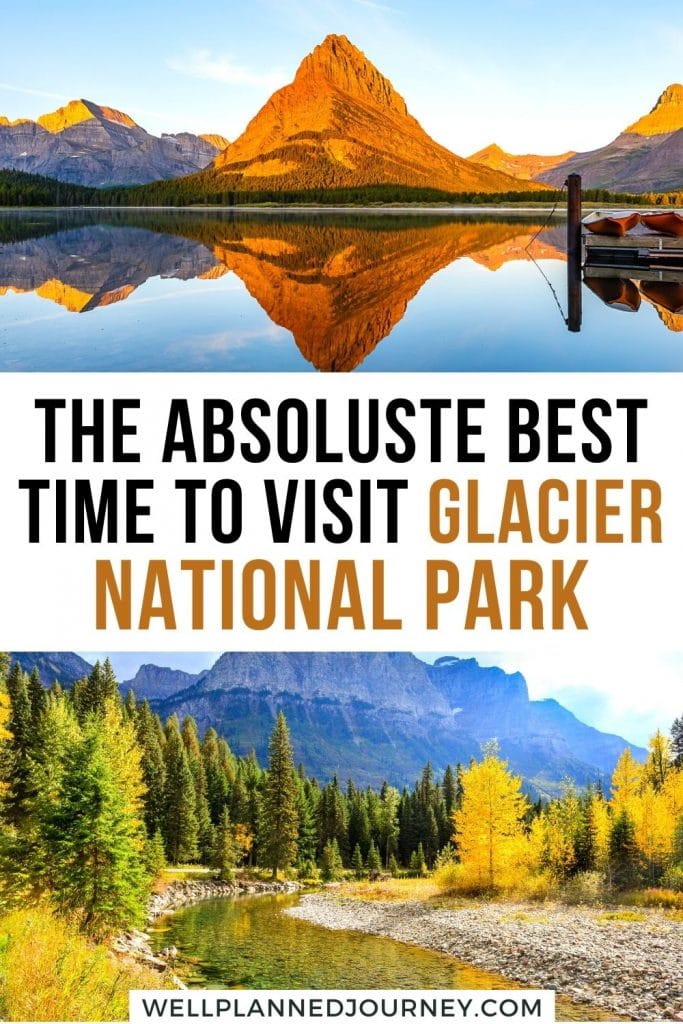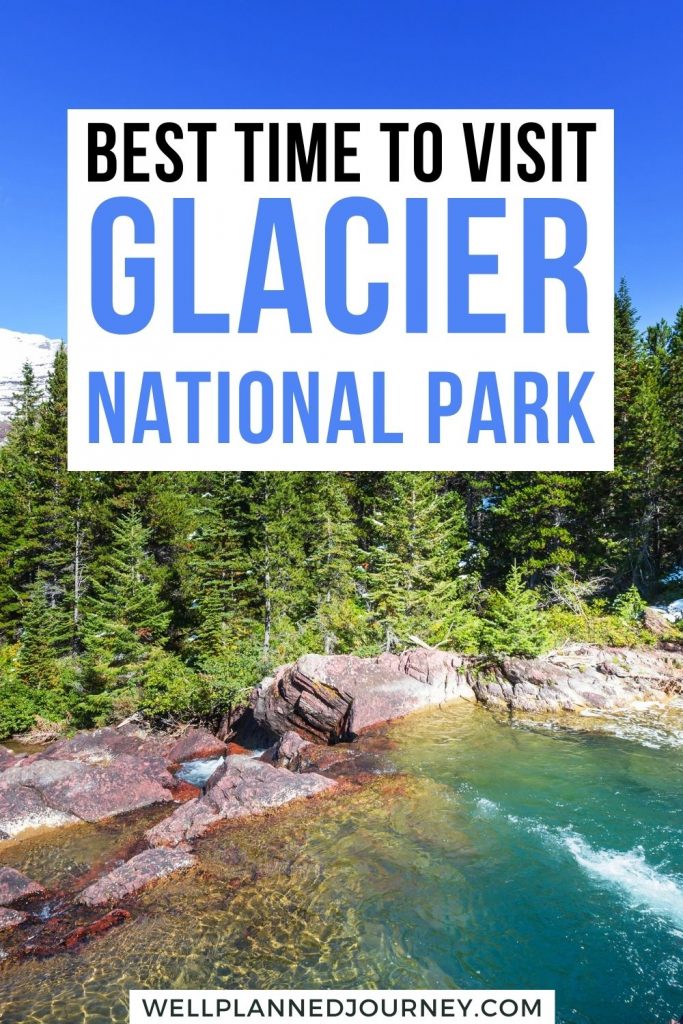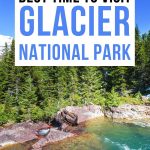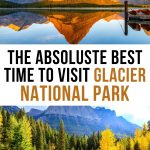Glacier National Park is home to sweeping mountain landscapes, impressive glaciers, and bucket list hikes. Each year, more than 3 million visitors flock to Glacier National Park.
Nearly 90% of those visitors come between June and September, but is that the best time to visit Glacier National Park?
Every season in Glacier National Park has something to offer. There’s something for every traveler, from remote, snowy winters to brilliant hiking trails in the summer.
This guide covers everything you need to know about finding the best time to go to Glacier National Park, including an overview of each season and the best time to visit for hiking, camping, and more!
Important Note
Glacier National Park requires all visitors to have a reservation to enter Going-to-the-Sun Road, North Fork, and Many Glacier starting May 24 until September 8, 2024. Read more about the Glacier National Park reservation system.
Are you looking for more ideas for your trip to Glacier National Park? Check out these posts!
- 21 Best Things to Do in Glacier National Park
- 3 Day Glacier National Park Itinerary
- 7 Day Glacier National Park Itinerary
This post may contain affiliate links, where I may receive a small commission at no additional cost to you. Read more in this disclosure policy.
Glacier National Park At-A-Glance
Before diving in, here are a few highlights to help you plan your trip:
- Best Time to Visit: Summer is the best (and most popular) time to visit, thanks to the warm weather and all park facilities being open. Visit in early to mid-September to avoid peak crowds.
- Where to Stay: If you’re looking to stay in the park, I highly recommend the Many Glacier Hotel. To stay outside the park, look for accommodations in Babb or St. Mary, like St. Mary Village.
- How to Get There: Glacier Park International Airport (FCA) in Kalispell, Montana, is the closest airport. Use Expedia to browse flights and find the best price.
- How to Get Around: The best way to get around the park is by car. Use Expedia to browse deals on rental cars or rent an RV or campervan with Outdoorsy!
- Best Self-Guided Tour: My favorite way to learn more about the park is with GyPSy Guides, a narrated self-guided tour perfect for road trips and scenic drives. The Glacier Going-to-the-Sun Road Guide provides incredible commentary and detail about history and geology.
- Don’t Forget: Be sure to get an America the Beautiful National Park Pass ahead of time. This $80 pass is valid for 12 months and gets you into all 400+ national park sites (including Glacier!).
Overview of Weather at Glacier National Park by Season
Glacier National Park experiences warm, sunny summers and cold, snowy winters. The average temperature in the park is also vastly different based on elevation. The lower elevation areas, like West Glacier, are typically 10 to 15 degrees warmer than Logan Pass, the highest elevation area of the park.
Because Glacier has dramatically different seasons, the best things to do in Glacier National Park change with each season.
This guide covers what to expect during each season in Glacier National Park, including weather, crowds, what’s open, and the best things to do.
Spring in Glacier National Park
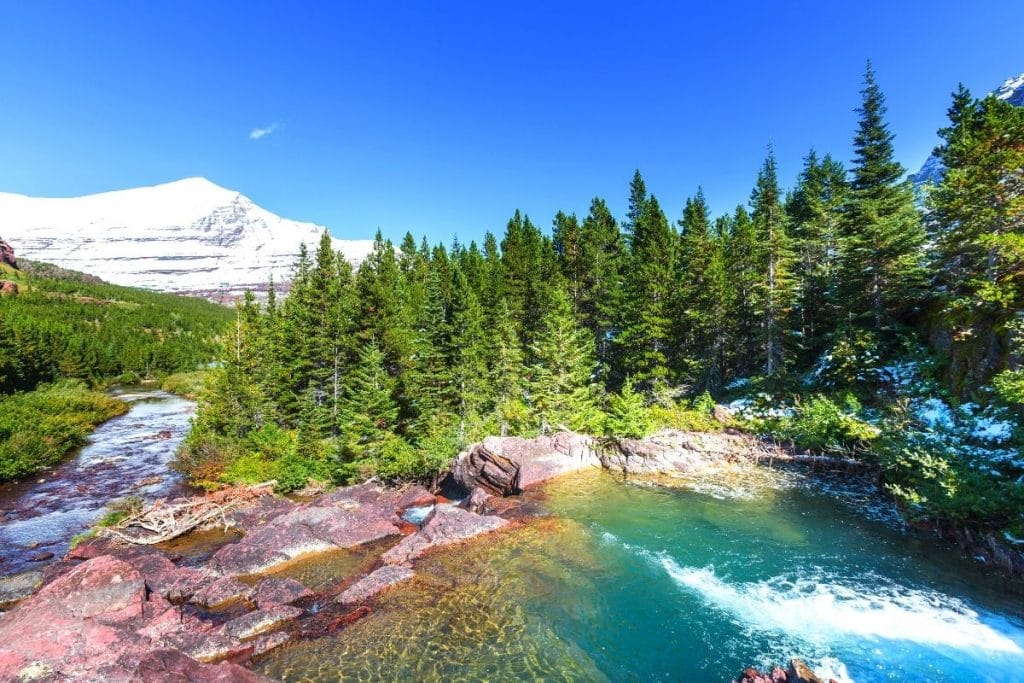
Glacier National Park in the spring is freezing, snowy, and quiet. Most hiking trails and roads are still snow-covered through the Spring. Then, finally, wildlife slowly re-emerges after a harsh winter, and plowing of the park’s roads begins.
Much of the park, including visitor centers, roads, and trails, remains closed through the spring season, typically not opening until Memorial Day at the end of May. So if you’re visiting Glacier in the spring, be prepared for winter-like conditions.
While amenities are still closed in early May, this is an excellent time for serious bicyclists to visit. While plowing is underway on Going-to-the-Sun Road, the already plowed sections are open to hikers and bikers only.
Spring is a great time to visit Glacier National Park for those comfortable with colder temperatures, snowy weather, and looking to avoid crowds. You’ll also find more budget-friendly accommodation outside the park ahead of the peak season.
Where to Stay in Glacier National Park in the Spring
Most lodging inside Glacier National Park remains closed through the Spring. However, in mid-to-late May, the lodges in Lake McDonald and Apgar Village on the park’s west side open.
Since the only part of the park that is accessible is the stretch between Apgar Village and Lake McDonald, I highly recommend staying on the west side of the park in the spring.
This interactive map can help you search all the available hotels and rental properties near Glacier National Park! Simply scroll and click the map below to see what is available!
These are the best hotels open in the Spring near Glacier National Park:
- Lake McDonald Lodge, located inside the park, opens in mid-May
- Motel Lake McDonald situated inside the park opens in late May
- Village Inn at Apgar, located inside the park, opens in mid-May
- Apgar Village Lodge & Cabins, located inside the park, opens in mid-May
- Belton Chalet, situated outside the park in West Glacier, opens in mid-May
- Glacier Guides Lodge, situated outside the park in West Glacier, opens in early May
- Great Northern Resort, located outside the park in West Glacier, opens in early May
If you’re visiting in early spring, consider staying in Columbia Falls, Kalispell, or Whitefish for more options.
Read More: 35 Best Places to Stay in Glacier National Park
If you’re looking to camp in Glacier National Park, these are the campgrounds that are open in the spring:
- Apgar Campground offers primitive, first-come, first-served camping year-round
- Sprague Creek Campground opens in mid-May and accepts reservations
- Bowman Lake Campground opens in mid-May and is first-come, first-served
Glacier National Park in March
March is a harsh, cold month in Glacier National Park. Daytime temperatures hover just above freezing, and nighttime temperatures are often in the teens. As a result, most park amenities, like lodging, roads, and trails, remain closed.
With around 1,000 visitors per day, crowds are few and far between. The most accessible area of the park is the stretch of Going-to-the-Sun Road between Apgar Village and Lake McDonald Lodge. The rest of Going-to-the-Sun Road and most hiking trails remain closed.
The Apgar Visitor Center is open on weekends only in March.
March can be an excellent time to avoid crowds if you don’t mind snowy, cold weather and only plan to visit the Lake McDonald area.
- Average High (West Glacier): 43°
- Average Low (West Glacier): 25°
- Average High (Logan Pass): 35°
- Average Low (Logan Pass): 17°
- Snowfall: 14.5 inches
- Average Daily Visitors: 1,000
Glacier National Park in April
The weather in Glacier National Park in April is unpredictable. Daytime temperatures can get into the 40s and 50s, but nights are below freezing. As a result, most park amenities, including visitor centers and lodges, are still closed.
The melted snow fuels the rivers, lakes, and waterfalls throughout the park. April is a transition month, with some hiking trails at lower elevations near Lake McDonald becoming more accessible.
Plowing of Going-to-the-Sun Road typically begins in April but won’t be finished until June or July. By late April, Going-to-the-Sun Road is open to Avalanche Creek for vehicles. Past that point, Going-to-the-Sun Road is accessible by hikers and bikers only while plowing is still in progress.
Most lodges remain closed through April as plowing is underway. The Apgar Visitor Center is open on weekends only in April.
Like March, April can be an excellent time to avoid crowds in Glacier if you can brave the cold temperatures and only want to explore at lower elevations.
- Average High (West Glacier): 54°
- Average Low (West Glacier): 31°
- Average High (Logan Pass): 44°
- Average Low (Logan Pass): 24°
- Snowfall: 3.5 inches
- Average Daily Visitors: 1,770
Glacier National Park in May
By May in Glacier National Park, snowfall is rare, plowing of park roads is well underway, and daytime temperatures are in the 50s and 60s. Lodges and visitor centers begin to open in mid-May. May is a great time to visit Glacier National Park to avoid crowds.
The lower elevations, like West Glacier, are mostly snow-free by May. Going-to-the-Sun Road is plowed to Avalanche Creek, with further sections towards “The Loop” open to bikers and hikers only.
If you are set on visiting Glacier National Park in the spring, May is the best month to do so. More park amenities are available, and you’ll beat the crowds that ramp up after Memorial Day.
- Average High (West Glacier): 65°
- Average Low (West Glacier): 38°
- Average High (Logan Pass): 53°
- Average Low (Logan Pass): 30°
- Snowfall: 0.4 inches
- Average Daily Visitors: 5,655
Summer in Glacier National Park

Summer is the busiest time of year in Glacier National Park. Roads, hiking trails, lodges, and visitor centers are all open. Temperatures are warm, sometimes reaching the 80s, and conditions are snow-free, perfect for exploring the park.
Glacier National Park’s summer season typically kicks off in late June or early July when Going-to-the-Sun Road opens in its entirety. However, because of the ideal conditions, summer brings heavy crowds. The crowds can mean long lines to enter the park and limited parking at trailheads.
Overall, summer is the best time to visit Glacier National Park, as long as you take steps to avoid crowds.
To combat the crowds in 2024, Glacier National Park has implemented a reservation system. To learn more, check out this post on the 2024 Glacier National Park reservations.
How to Avoid Crowds in Glacier National Park in the Summer
The best way to avoid crowds in Glacier National Park is to arrive at trailheads or parking lots before 8 am. The park is most crowded between 10 am and 3 pm, so arriving early will help you avoid lines at the entrance station, find parking easily, and avoid crowds on the hiking trails.
For popular parking areas, like Logan Pass Visitor Center, I recommend arriving around 7 to 7:30 am to ensure you find a parking spot. You may also have luck visiting areas like Logan Pass or Many Glacier in the late afternoon, after 5 pm, when crowds have left for the day.
Another option for avoiding crowds is to visit off-the-beaten-path destinations. Areas like Bowman Lake and Two Medicine offer spectacular scenery and fewer crowds. If you visit in the early morning, you may even have the place to yourself!
However, it’s important to note that you’ll need a reservation for the Bowman Lake and the North Fork area in 2024.
Lastly, consider taking a trip into the backcountry if you seek true isolation. Glacier National Park requires backpackers to get a backcountry permit, available in advance via a lottery system. There are also a limited number of permits available on a walk-up basis.
You can read more about backcountry permits in Glacier here.
Where to Stay in Glacier National Park in the Summer
All Glacier National Park lodges and campgrounds are open in the summer, typically from late May or early June through mid-September.
However, due to the high visitation in the summer, lodging fills up far in advance. For summer reservations at the lodges in Glacier National Park, book 13 months out. For reservations at hotels near the park, try to book at least 6 to 9 months out for the best selection.
Staying on the east side of the park offers the best access to summer activities in Glacier, like St. Mary, Logan Pass, and Many Glacier. However, options are limited on the east side, so you’ll need to book far in advance.
This interactive map can help you search all the available hotels and rental properties near Glacier National Park! Simply scroll and click the map below to see what is available!
These are the best hotels open in the summer in and near Glacier National Park:
- Many Glacier Hotel located inside the park is open from early June to mid-September.
- Swiftcurrent Motor Inn and Cabins located inside the park is open from early June to mid-September.
- Rising Sun Motor Inn, located inside the park, is open from mid-June to early September.
- St. Mary Village, located in St. Mary just outside the park, is open from early June to mid-September.
- The Cottages at Glacier, located in St. Mary just outside the park, is open from mid-May to late September.
Read More: 35 Best Places to Stay in Glacier National Park
All park campgrounds are open during the summer months, offering first-come, first-served and reservable campsites. Read more about camping in Glacier National Park here.
Glacier National Park in June
June is the start of the peak season in Glacier National Park. Going-to-the-Sun Road typically opens in late June or early July, allowing visitors to see more of the park. In addition, visitor centers, lodges, and campgrounds are open for the season, and hiking trails are mostly snow-free.
While the park is still ramping up in June, visiting in mid-to-late June can be a great time to hike and see wildlife. While you risk that areas like Logan Pass will not be open, there is still plenty to explore in West Glacier, St. Mary, and Many Glacier.
June is an excellent time to visit for those that want summer temperatures but wish to avoid peak summer crowds.
- Average High (West Glacier): 72°
- Average Low (West Glacier): 44°
- Average High (Logan Pass): 60°
- Average Low (Logan Pass): 36°
- Snowfall: 0.2 inches
- Average Daily Visitors: 19,575
Glacier National Park in July
July is the busiest month in Glacier National Park, with over 25,000 visitors each day. Warm weather and road and trail conditions are perfect for hikers and drivers alike. Going-to-the-Sun Road fully opens in late June or early July. Park amenities like lodges, visitor centers, and shuttle services are fully operational.
Daytime temperatures are warm, often in the low 80s, and conditions are ideal for hiking the park’s numerous trails. If you plan to visit in July, start your day early to avoid crowds. Plan to arrive at trailheads before 8 am.
Overall, July is an excellent time to see the beauty of Glacier National Park as long as you don’t mind crowded trails and parking lots.
- Average High (West Glacier): 80°
- Average Low (West Glacier): 48°
- Average High (Logan Pass): 69°
- Average Low (Logan Pass): 41°
- Snowfall: 0 inches
- Average Daily Visitors: 25,705
Glacier National Park in August
August is a busy, warm month in Glacier National Park. With an average of 21,000 visitors per day, expect crowded conditions. However, August is an excellent time to visit since lodges, visitor centers, Going-to-the-Sun Road, and park shuttles are fully operational.
Much like July, August is warm during the days and cool at night. If you visit in August, plan to arrive at trailheads before 8 am to find parking and avoid congested trails.
August can be a great time to visit if you don’t mind the crowds and start your days early.
- Average High (West Glacier): 79°
- Average Low (West Glacier): 47°
- Average High (Logan Pass): 68°
- Average Low (Logan Pass): 40°
- Snowfall: 0 inches
- Average Daily Visitors: 21,633
Don’t miss the best sights in Glacier on your upcoming trip! This free, printable guide to Going-to-the-Sun Road covers all the best points of interest, tips for avoiding crowds along Glacier’s best scenic drive, and an exclusive map!
Download your free Going-to-the-Sun Road guide here.
Fall in Glacier National Park
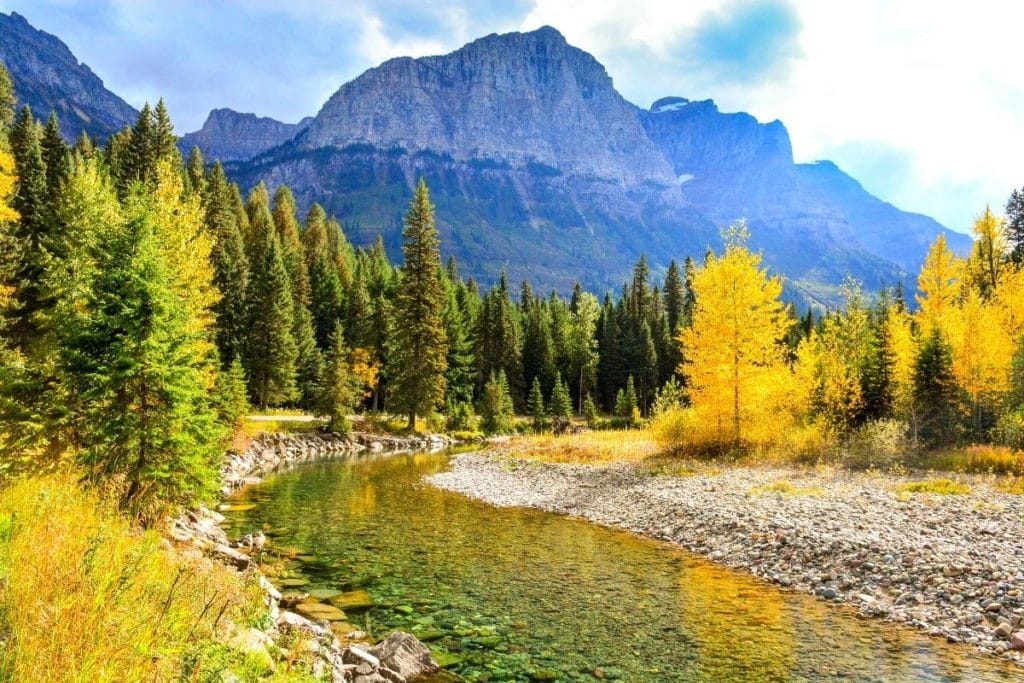
Fall is a beautiful time of year in Glacier National Park. Crowds decrease after Labor Day, and fall foliage is on full display. Wildlife is more active, particularly bears preparing for hibernation. However, much of the park shuts down after September, preparing for the upcoming winter.
By mid-September, most lodges and campgrounds close for the season. Going-to-the-Sun Road closes for the season by early October, except for the lower elevation stretches near the park entrances.
If you want to avoid crowds and still benefit from summer temperatures and amenities, visit Glacier National Park the week following Labor Day in early September.
If you want to see peak fall colors and don’t mind fewer amenities and colder weather, visit in late September or October instead.
Important Note
Glacier National Park requires all visitors to have a reservation to enter Going-to-the-Sun Road, North Fork, and Many Glacier starting May 24 until September 8, 2024. Read more about the Glacier National Park reservation system.
Where to Stay in Glacier National Park in the Fall
Lodges and campgrounds inside Glacier National Park close in early fall, typically by mid-to-late September. Going-to-the-Sun Road generally closes in early October, and heavy snowfall begins shortly after that.
Early to mid-September is an excellent time to find lodging in Glacier National Park. Crowds tend to decrease after Labor Day, but most of the park’s amenities are still open for another few weeks.
However, lodging still fills up far in advance. For lodges in Glacier National Park, book 13 months out. For reservations at hotels near the park, try to book at least six months out for the best selection.
Staying on the east side of the park offers the best access to activities in Glacier, like St. Mary, Logan Pass, and Many Glacier. However, options are limited on the east side, so you’ll need to book far in advance.
This interactive map can help you search all the available hotels and rental properties near Glacier National Park! Simply scroll and click the map below to see what is available!
These are the best hotels open in the early fall near Glacier National Park:
- Many Glacier Hotel located inside the park closes in mid-September
- Swiftcurrent Motor Inn and Cabins situated inside the park closes in mid-September
- St. Mary Village, located in St. Mary just outside the park, closes in mid-September.
- The Cottages at Glacier, located outside the park in St. Mary, closes in late September
- Belton Chalet, located outside the park in West Glacier, closes in mid-October
- Glacier Guides Lodge, situated outside the park in West Glacier, closes in mid-October
- Great Northern Resort, located outside the park in West Glacier, closes in mid-October
Read More: 35 Best Places to Stay in Glacier National Park
If you’re looking to camp in Glacier National Park, these are the campgrounds that are open in the early-to-mid Fall:
- Apgar Campground is open year-round, converting to primitive, first-come, first-served status after November 1
- Bowman Lake Campground closes in late October and is first-come, first-served
- Two Medicine Campground closes in late October and is first-come, first-served
Glacier National Park in September
After Labor Day in early September, crowds in Glacier National Park drop significantly. However, temperatures are comfortable for the next few weeks until mid-September and park lodges and amenities, including Going-to-the-Sun Road, remain open until late September.
Early September after Labor Day weekend is the best time to visit Glacier National Park if you want to avoid crowds but still enjoy hiking and summer amenities.
However, most lodges and campgrounds inside the park begin to close by late September. By the end of the month, fall colors are out in full force. If you don’t mind staying outside the park, late September can be a great time to visit.
- Average High (West Glacier): 68°
- Average Low (West Glacier): 39°
- Average High (Logan Pass): 58°
- Average Low (Logan Pass): 34°
- Snowfall: 0.1 inches
- Average Daily Visitors: 17,780
Glacier National Park in October
October weather in Glacier National Park can be unpredictable. Days can be sunny in the 50s or rainy and colder. It’s not uncommon to have an early snowstorm in October that shuts down areas of the park. Going-to-the-Sun Road typically closes for the season in early October.
All park lodges and most campgrounds are closed by the end of October. Temperatures drop below freezing overnight, and the park prepares for the upcoming harsh winter, which typically kicks off in mid-November.
If you want to see fall colors and don’t mind that the park is more primitive, October can be a great time to visit Glacier National Park.
- Average High (West Glacier): 53°
- Average Low (West Glacier): 32°
- Average High (Logan Pass): 44°
- Average Low (Logan Pass): 28°
- Snowfall: 2 inches
- Average Daily Visitors: 4,825
Glacier National Park in November
November in Glacier National Park is the start of the wintry season. As a result, all lodges and visitor centers are closed. In addition, Going-to-the-Sun Road and Many Glacier Road are closed for the season. The most accessible area of the park in November is Apgar Village and Lake McDonald.
On average, November in Glacier gets nearly 2 feet of snow, and snowstorms are common. Temperatures are barely above freezing, even during the daytime. Crowds are almost non-existent, with less than 1,000 daily visitors.
If you want to experience wintry weather in Glacier National Park but don’t want to visit in the heart of winter, consider planning your trip in November. First, however, you’ll need to be prepared for cold weather and primitive conditions in the park.
- Average High (West Glacier): 38°
- Average Low (West Glacier): 25°
- Average High (Logan Pass): 31°
- Average Low (Logan Pass): 20°
- Snowfall: 17.2 inches
- Average Daily Visitors: 875
Winter in Glacier National Park
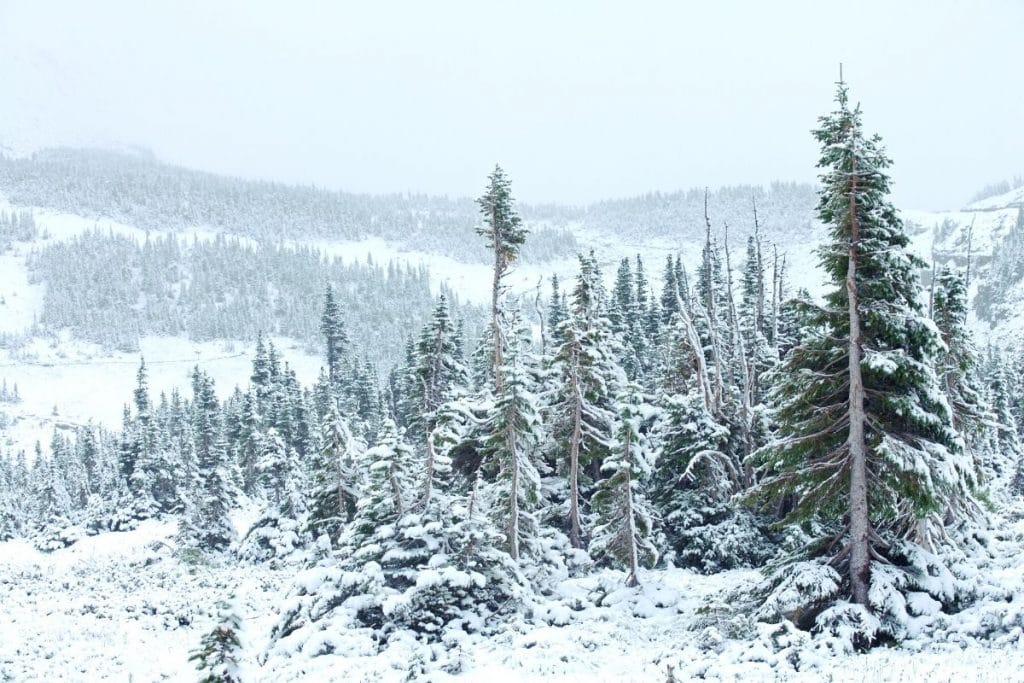
Winter in Glacier National Park is highly primitive and harsh. Temperatures are barely above freezing, and snowfall averages nearly 40 inches per month. Consequently, very few visitors brave the cold temperatures to explore Glacier National Park in the winter.
Glacier National Park’s winter season is also long, with winter-like conditions lasting from late October to mid-May. As a result, most park amenities, including lodges, visitor centers, and scenic drives, are closed during these months.
In the winter, the most accessible area of Glacier National Park is the stretch of Going-to-the-Sun Road between Apgar Village and Lake McDonald.
If you want to avoid crowds and participate in winter sports like snowshoeing or cross-country skiing, visiting Glacier in the winter can be a good fit. However, for most visitors, Glacier National Park conditions are not ideal in the winter.
Where to Stay in Glacier National Park in the Winter
Most lodging inside the park is closed from mid-Fall to late Spring. Your best bet is staying outside the park in larger towns like Columbia Falls, Kalispell, or Whitefish in the winter. These towns offer more year-round accommodations.
This interactive map can help you search all the available hotels and rental properties near Glacier National Park! Simply scroll and click the map below to see what is available!
These are the best hotels open in the winter near Glacier National Park:
- North Forty Resort in Columbia Falls
- Cedar Creek Lodge in Columbia Falls
- Lodge at Whitefish Lake in Whitefish
- Kandahar Lodge at Whitefish Mountain Resort in Whitefish
- Country Inn & Suites Glacier Lodge in Kalispell
- SpringHill Suites Kalispell in Kalispell
Read More: 35 Best Places to Stay in Glacier National Park
The only campground in Glacier National Park open year-round is the Apgar Campground. It operates in the winter as a primitive, first-come, first-served campground and is the only lodging available inside the park.
Glacier National Park in December
December is the coldest month in Glacier National Park, with temperatures rarely above freezing. Most days are in the 20s, with overnight temperatures in the teens. Snowfall is heavy with frequent snowstorms. Snowshoeing or cross-country skiing are common sports in Glacier National Park in December.
Glacier National Park sees the fewest visitors in December, with only around 500 daily visitors to the park. For those that don’t mind the cold temperatures and want to explore Glacier’s winter wonderland, December can be an excellent time for solitude.
- Average High (West Glacier): 30°
- Average Low (West Glacier): 18°
- Average High (Logan Pass): 25°
- Average Low (Logan Pass): 12°
- Snowfall: 37.5 inches
- Average Daily Visitors: 570
Glacier National Park in January
Like other winter months, January in Glacier National Park is freezing, snowcovered, and quiet. With less than 1,000 daily visitors, there’s no shortage of solitude in Glacier National Park. The most accessible area is West Glacier to Lake McDonald.
In January, visitors can snowshoe and cross-country ski in the western part of the park and drive the short section of Going-to-the-Sun road that is regularly plowed. So if you want to participate in winter sports in Glacier, January is an excellent time to visit.
- Average High (West Glacier): 30°
- Average Low (West Glacier): 17°
- Average High (Logan Pass): 27°
- Average Low (Logan Pass): 12°
- Snowfall: 39.6 inches
- Average Daily Visitors: 755
Glacier National Park in February
While February is the last month of winter in many places across the United States, winter still has many more months in Glacier National Park. February sees freezing temperatures and heavy snowfall, but conditions are slightly better than in December or January.
February is the ideal time to explore winter in Glacier National Park. Whether you choose to snowshoe or cross-country ski or drive Going-to-the-Sun Road from Apgar Village to Lake McDonald, you’ll find plenty of winter activities.
- Average High (West Glacier): 34°
- Average Low (West Glacier): 19°
- Average High (Logan Pass): 28°
- Average Low (Logan Pass): 10°
- Snowfall: 22.5 inches
- Average Daily Visitors: 615
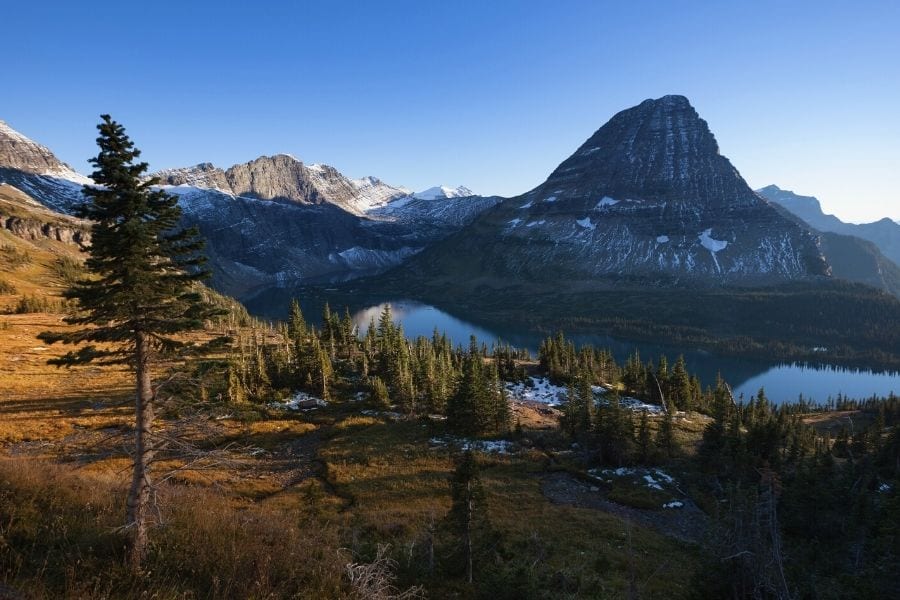
When is the best time to visit Glacier National Park?
The best time to visit Glacier National Park is late June to mid-September. All park lodges, visitor centers, campgrounds, roads, and hiking trails are open during the summer months. However, summer can be crowded. To avoid crowds, visit in early-to-mid September after Labor Day.
You can expect Going-to-the-Sun Road to open in late June or early July, making the park much more accessible. In addition, the park is snow-free, making for perfect hiking and driving conditions. Summer also brings beautiful wildflowers and plentiful wildlife.
If you’re interested in specific activities in Glacier National Park, like hiking, camping, or wildlife sightings, keep reading for the best time to visit Glacier for that particular activity!
Best Time to Hike in Glacier National Park
The best time to hike in Glacier National Park is from July to mid-September. During these months, the trails are snow-free, and the weather is warm. In addition, by early July, Going-to-the-Sun Road is open across Logan Pass, granting access to trailheads for some of the best hikes in the park.
Iconic trails like the Highline Trail, Hidden Lake Overlook, and Ptarmigan Tunnel are only accessible in the summer. However, expect heavy crowds on hiking trails in the summer. To avoid crowds, arrive at trailheads before 8 AM.
You can read more about the best hikes in Glacier National Park here.
Best Time of Year to Drive Going-to-the-Sun Road
The best time to drive Going-to-the-Sun Road is from early July to late September. This famous scenic drive is typically open from late June or early July until late September or early October. To see the best parts of Going-to-the-Sun Road, you’ll want to visit in the summer when it is fully open.
Popular stops like The Loop and Logan Pass Visitor Center are only accessible once the road is fully open. In addition, trailheads to the Highline Trail and Hidden Lake Overlook are only accessible once Going-to-the-Sun Road is open.
You can read more about driving Going-to-the-Sun Road, including the best stops and all about the 2024 reservation system, here.
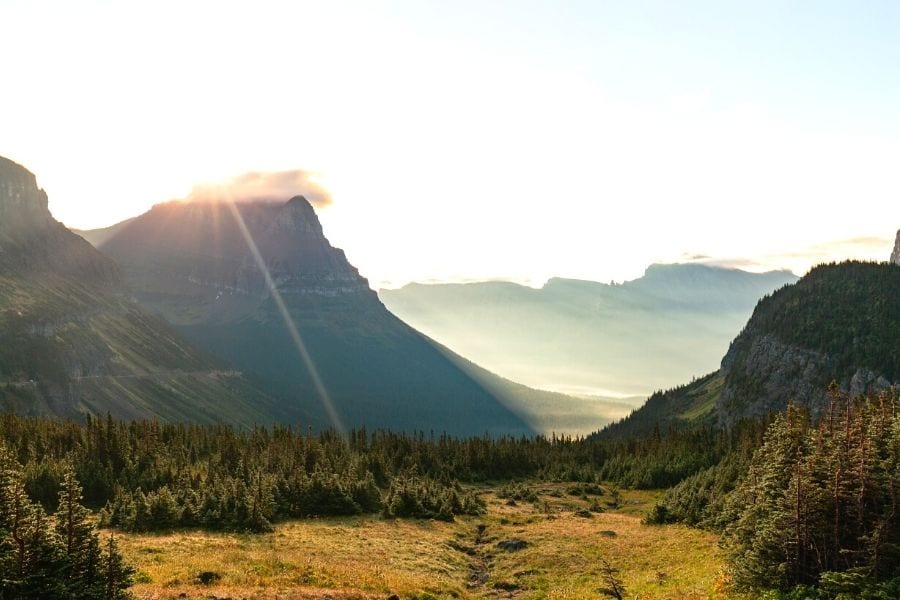
Best Time to Visit Glacier National Park to Avoid Crowds
Glacier National Park sees the fewest crowds from November to March in the winter. However, the park is primitive and harsh during these months. Therefore, the best time to visit Glacier with fewer crowds but still enjoy summer weather is mid-September, the week following Labor Day.
While you’ll still experience some crowds by visiting in mid-September, the trade-off is that lodges, visitor centers, campgrounds, hiking trails, and scenic drives are still open, making for a much more enjoyable experience.
Best Time to Visit Glacier National Park to See Wildlife
The best time to visit Glacier National Park to see wildlife is late summer or early fall. As the park quiets down after Labor Day and animals prepare for winter, you’ll see increased wildlife activity and an increased chance of seeing bears, moose, elk, bighorn sheep, mountain goats, and more!
Remember to stay at least 100 yards away from bears and 25 yards away from all other wildlife and respect their space. I highly recommend bringing along a pair of binoculars to get a closer look at wildlife.
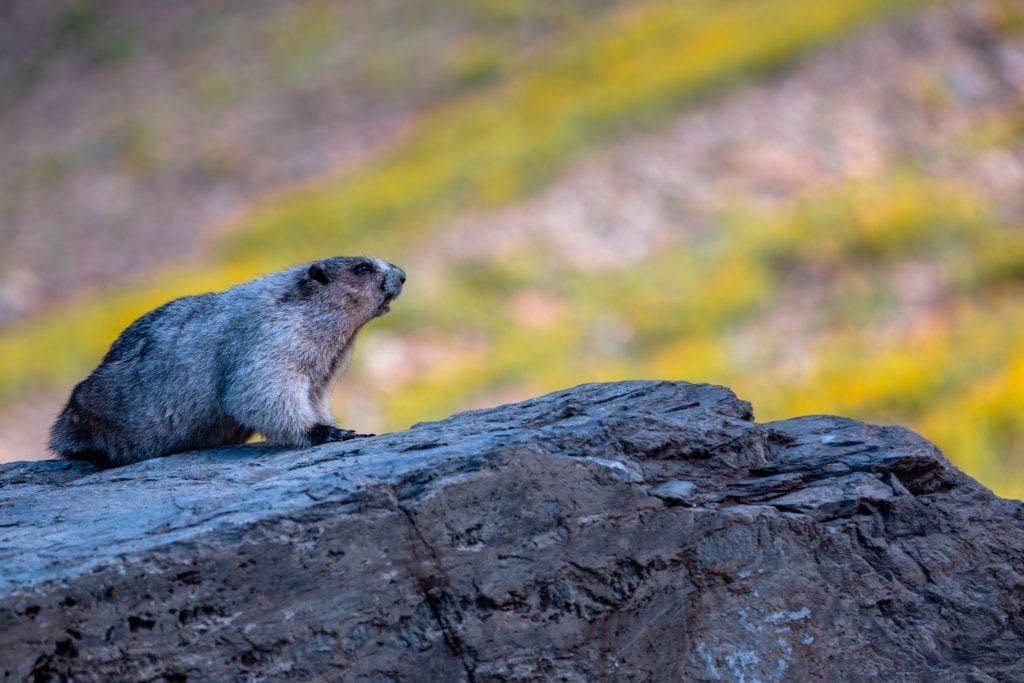
Best Time to Bike in Glacier National Park
The best time for biking in Glacier National Park is from late April to late May. Going-to-the-Sun Road is only open to pedestrian and bike traffic during these months. This narrow one-month window allows bikers unparalleled access to the stunning scenic drive while plowing is still underway.
Once Going-to-the-Sun Road is fully open to vehicle traffic in the summer months, biking is not allowed during peak hours. Therefore, if you visit during the summer, the hours and areas where you can bike Going-to-the-Sun Road will be limited. That limited biking ability is why most cyclists visit Glacier National Park in the late spring instead.
You can read more about biking in Glacier National Park here.
Best Time to Camp in Glacier National Park
The best time to camp in Glacier National Park is late summer through mid-Fall. Unfortunately, many reservable sites close by mid-September if you’re looking for a reservable campground. However, if you’re open to more primitive camping, you can find first-come, first-served sites in the park open through October.
A benefit of camping in the fall, particularly after mid-September, is that crowds are fewer, and you’ll have an easier time getting a campsite. However, temperatures drop quickly in the fall, so you’ll need to be prepared for colder overnight conditions and fewer park amenities.
You can read more about camping in Glacier National Park here.
Best Time for Photography in Glacier National Park
The best time to photograph Glacier National Park will depend on what you’re trying to capture. The best time to visit is from July to September for waterfalls, wildflowers, and popular areas like Many Glacier or Logan Pass. For fall foliage and wildlife, visit in September or October. For snowy landscapes, visit from November to April instead.
Regardless of what time you choose to visit, you can capture beautiful photos (and avoid crowds!) around sunrise and after sunset. Glacier National Park’s night skies also provide excellent opportunities for astrophotography.
Best Time for Whitewater Rafting in Glacier National Park
Mid-May to early July is an excellent time to go whitewater rafting in Glacier National Park. The snowmelt provides rushing rapids in late spring and early summer, perfect for whitewater enthusiasts. For more family-friendly rapids, consider visiting from July to September instead.
There are four whitewater rafting tour operators authorized to operate in Glacier National Park:
- Glacier Guides and Montana Raft Company
- Glacier Raft Company
- Great Northern Resort
- Wild River Adventures
Best Time for Boating in Glacier National Park
The best time for boating in Glacier National Park is in the summer months, from June to September. If you want to bring your boat, the season opens on June 1 and closes in October, and you’ll need a special permit. All boats must be inspected before entering the lakes.
If you want to rent non-motorized boats or take a boat tour instead, the best time to visit is from May to September, when Glacier Park Boat Company is operating.
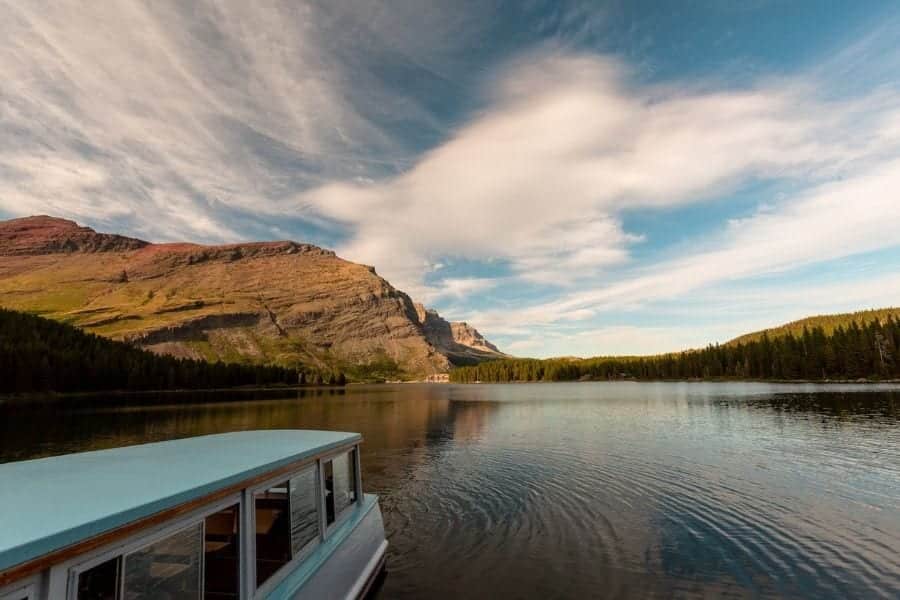
Best Time to Go Fly Fishing in Glacier National Park
The best time for fly fishing in Glacier National Park is early June to late October. During these months, temperatures are warmer, making fly fishing more palatable for most visitors. In the off-season, visitors can also try their hand at ice fishing and classic line fishing instead.
You can read more about fly fishing in Glacier National Park here.
Best Time to Go to Glacier National Park for Cross-Country Skiing or Snowshoeing
The best time to go cross-country skiing or snowshoeing in Glacier National Park is from December to March, when the park is a winter wonderland. The heavy snowfall in the winter blankets the park in powdery snow, perfect for winter sports. The popular areas to cross-country ski include Apgar Village near West Glacier, McDonald and Avalanche Creeks, Polebridge, St. Mary, and the Two Medicine Valley.
You can read more about cross-country skiing in Glacier National Park here.
Best Time to See Northern Lights Glacier National Park
The best time to see the Northern Lights in Glacier National Park is late fall until early spring when nights are long and dark. You’ll want a dark night without light pollution to see the Northern Lights. The best time to see the light show is an hour before or after midnight.
You can read more about the best spots for catching the Northern Lights in Glacier.
Best Time to Visit Glacier National Park for Snow
If you want to see Glacier National Park covered in snow, the best time to visit is from November to April. During these months, the park gets heavy snowfall, and it is the peak winter sports season. If you love snowshoeing or cross-country skiing, the winter can be a great time to visit.
Keep in mind that the winter months in Glacier National Park are very harsh, and there are no park amenities. Therefore, if you visit in the winter, you will need to be self-sufficient.
Best Time to Visit Glacier National Park for Fall Colors
The best time to see fall colors in Glacier National Park is from mid-September until mid-October. The trees on the lower elevation west side of the park start changing around mid-September. The trees on the east side of the park tend to change around early October. If you’re looking for larches, these colorful trees typically change in mid-October.
While fall is beautiful, it is a more remote time to visit Glacier National Park. Most lodges and park amenities close around mid-September. Going-to-the-Sun Road typically closes in late September or early October. Staying in the fall means being more self-sufficient.
Best Time to Visit Glacier National Park for Warm Weather
If you want to visit Glacier National Park in warm weather, the best time is in the summer, from late June to early September. During these months, daytime temperatures are in the 70s and 80s with cooler nighttime temperatures. Summer is a great time to go hiking, but remember to bring a rain jacket for the occasional thunderstorm!
Worst Time to Visit Glacier National Park
The worst time to visit Glacier National Park is in the winter, from November to April. Part of what makes winter the worst time to visit is that amenities like lodges, visitor centers, roads, and hiking trails are closed. In addition, temperatures are rarely above freezing, and snowfall is heavy.
However, if you despise crowds above all else, you may consider July and August the worst time to visit.
Cheapest Time to Visit Glacier National Park
The cheapest time to visit Glacier National Park is during the winter, from November to April. The park entrance fee drops from $35 per week to $25 per week as most park amenities are closed. In addition, lodging outside the park in areas like Columbia Falls and Kalispell tends to be less expensive in the off-season.
Final Thoughts on the Best Time of Year to Visit Glacier National Park
No matter the time of year, you’ll have a great trip to Glacier National Park. Visiting in the winter requires more planning and cold-weather gear but can be rewarding if you seek minimal crowds.
The best time to visit Glacier National Park is summer, from late June until mid-September. All park roads, lodges, campgrounds, and hiking trails are open, and the weather is pleasant for outdoor exploration.
Are you looking for more helpful tips to plan your trip to Glacier National Park? Read these posts!
- Activities: 21 Best Things to Do in Glacier
- Where to Stay: 35 Best Places to Stay in Glacier
- 3 Day Itinerary: How to Spend 3 Days in Glacier
- 7 Day Itinerary: How to Spend 7 Days in Glacier
- Hiking: 19 Best Hikes in Glacier National Park
- Scenic Drive: Going-to-the-Sun Road in 2024
- Highline Trail: How to Hike the Highline Trail
Don’t miss the best sights in Glacier on your upcoming trip! This free, printable guide to Going-to-the-Sun Road covers all the best points of interest, tips for avoiding crowds along Glacier’s best scenic drive, and an exclusive map!
Download your free Going-to-the-Sun Road guide here.
Don’t Forget to Save This Post on Pinterest
